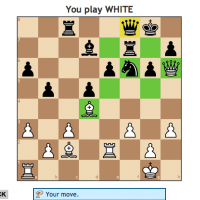
My First Mentor Course!!
I am really excited to announce that on July 1st chess.com will publish a Chess Mentor course of mine for the first time!! So excited that I'm giving you a sneak peak, in hopes that more of you will try it out. Also, once the course comes out, I will add a link to it here, and the comments section of this blog will be a good place to give me your feedback.
Alright, so here's what it's all about (some really sharp readers may already have guessed from the picture I used):
Weak Color Complexes Explained
Being sensitive to weak color complexes provides extremely important insight into positional and tactical chess play. It often shapes the entire middlegame struggle, and informs the decisions made as early as the opening phase of the game. Yet many players don't even know what a "weak color complex" is; and many others know of it, but partly wonder if it's an artificial abstraction invented by secret grand mages of chess's professional society in order to cloud their art in obscurity.
But weak color complexes most definitely do exist, and-- if you have already acquired some basic calculation skills, and put a serious dent in the frequency of your blunders-- you need to have some idea of what they are in order to grasp at the true nature of chess.
This exhortation is followed by an invitation: work your way through the introductory course offered here, and I promise you will:
- Know what a weak color complex is;
- Be able to look at a position and determine whether it has a weak color complex as a feature;
- Know a couple way to create a weak color complex;
- Know a couple ways to exploit a weak color complex, and the sad sod saddled with it.
Here is a special preview: a game in which a weak color complex is the dominant strategic theme, with explanations. An excerpt from this game is used for one of the lessons in the course.
Ok, time for a first question. What is black intending to do next move? How should white play? If you are not paying attention to the fight for color complexes, then as black you might just have castled without consideration last move instead of playing Nc6, and as white you might just do the same on this move!
Ok, so to summarize the answer to the previous question: development is very important at this stage in the game. So it doesn't matter whether white plays O-O or Bf4 first: either one prevents e5 by black, because black can not yet afford to spend the tempo on it. Notice that if white had spent a tempo on a move like a3 or Qb3 earlier in the game, black would have time to set up O-O and e5 and get a decent position. Finally, if white plays Bf4 and black calmly castles, white should not go in to d6: it's too costly in terms of development. He should just calmly castle himself, and get the same position as if you castle first. Back when I played this game (at a youth tournament in France in 2001), I thought that white could go in to d6, and that Bf4 was the only way to stop e5, but now I have a better feel for what you have time for in the opening. Both O-O and Bf4 are good, but no other move is any good!
[Also note that I've given you a sneak preview of the way I ask my questions in tricky ways; I made it sound like castling was wrong, but it was correct! (technically I only said that castling without thought was wrong; this was a critical position, so you should definitely consider whether or not black will be able to play e5 next move and what you should do about it). Never try to answer based on my syntax, but rather based on your own chess thoughts!]
And now to answer the short question from the previous diagram: it is certainly tempting to take cxd, removing your c3 pawn from attack, and establishing a beautiful center. But if you are paying close attention you will notice that Nxd4 is even stronger!! It threatens Nxc6 and Nb5, so black actually has to trade knights on d4 himself. Then you have traded a pair of knights with two excellent effects:
1) You have removed clutter on the g2-a8 diagonal, increasing the power of the Bg2 tremendously!
2) You have removed clutter on the dark squares, trading the black knight that was defending them, increaseing the power of the Bf4 significantly!
Hurray for paying attention!! The game continued:
To summarize the game that you have just seen: Bxc3+ was a concession that created the potential for black to eventually get a weak color complex. The strategy to deal with that problem would be to place the pawns on dark squares b6-c5 and d6-e5, keeping white's dark-squared bishop from ever getting loose; however black lacked the development to do so. When they made the mistake Qa5? they were then technically losing, as it created the tactical threat of Bxd6. Black could not deal with that without allowing the dark-squared bishop to get out of control. White easily converted the dark-squared weakness into a paralysis of the black pieces.
I hope that whet your appetite for the power that understanding color complexes will give to your chess game. Do not fret, do not call me a tease: I have released this blog when the wait is less than 24 hours!
